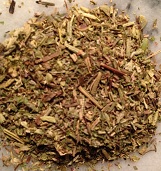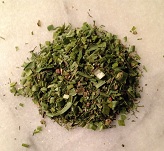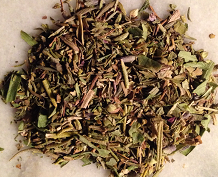French Food Spices
Quick Notes:
French food spices are herbs primarily. Basil, Bay, Marjoram, Parsley, Sage, Tarragon and Thyme are the dominant herbs. The Alliums (family of bulbs) including Chives, Garlic, Leeks, Onions, and Shallots are widely used too.
French cuisine is renowned for its herbs blends of Bouquet Garni, Fines Herbes and Herbes de Provence. Each of these mixtures features herbs from France’s southern region.
Besides herbs, French cuisine is primarily about provincial specialties, cooking techniques, and sauces.
When visiting France you'll want to savor the rich brew of an authentic Bouillabaisse stocked with Mediterranean fish, the simmering deliciousness of a cassoulet, the puffy airiness of quenelle de brochet, and the buttery goodness of crisp crepes, kouign amann, and cannellé.
Food travels through France should be all about the local and provincial fares of its twenty-two regions, with all of their individual nuances and specialties, wherein the roots of French cuisine are based.
There are five French "Mother Sauces" as every culinary student learns: Béchamel, Espagnole, Hollandaise, Tomato and Veloute.
 Béchamel Cheese Sauce
Béchamel Cheese SauceNumerous secondary sauces can be developed from these five. Also, now-a-days there are many varieties of sauces being made using fruit, nuts, seeds and vegetables as thickeners; however, within French cuisine, the five Mother Sauces still reign supreme.
Reducing or cooking down liquids from foods like raw tomatoes will result in a sauce; but, most liquids need some help in thickening. This is where roux comes in. Roux is a mixture of flour and fat, usually butter, cooked briefly to remove the pasty taste of the flour. For some southern dishes roux is cooked much longer until it acquires a nutty taste and is medium to dark brown in color. Liquid to be thickened is added to the roux and boiled until it becomes a sauce.
Traditionally four of the five mother sauces are made from roux. Hollandaise sauce, an emulsification made from egg yoke and butter, is never made with a roux. Tomato sauce, traditionally made with a roux, can be thickened quite easily without one.
French Cuisine Terminology:
Aioli - A garlic flavored mayonnaise (Hollandaise secondary sauce) popular in Provence, in the south of France as an accompaniment to seafood and vegetables.
Bain-marie - Water bath. Cooking technique where a food container is placed in a roasting pan or baking dish that is partially filled with boiling water. Allows food like custards to cook more slowly and not be subjected to direct high heat.
Béchamel - One of the five classic “Mother Sauces” used in French cuisine. It is a bland white sauce made with milk and roux, and flavored with bay leaves, nutmeg, white pepper and sometimes onion.
Beignet - Small deep-fried doughnuts resembling fritters dusted with powdered sugar
Beurre Blanc - Thick buttery sauce made by whisking cold butter into a reduction of white wine, vinegar and shallots. Served with poached fish.
Beurre Manie - Equal parts of butter and flour mixed together and used as a thickener for casseroles, soups and stews
Beurre Noisette - Golden-brown color cooked butter served as a sauce for fish
Bisque - Seafood soup made with shellfish stock
Blanch - Vegetables or fruits placed in boiling water so their skins can be removed more easily
Bouchon - tiny casual eateries with little elbow room
Bouillabaisse - “To boil, to reduce.” Mediterrannean seafood soup entrée popular in the south of France. 1980 The Charter of Bouillabaisse - protects both the dish’s integrity of using rockfish, St. Peter’s fish - Tilapia, monkfish, red mullet, conger eel; and, its serving ritual (filleting the fish tableside and serving it separate from the soup)
Bouillon - Broth or stock
Bouquet Garni - “Garnish Bouquet” - Classic French blend. A bundle of herbs (usually bay leaf, thyme, parsley, rosemary, leek) tied together (fresh herbs) or tucked in a sachet/cheesecloth (dried herbs), and used to flavor soups, stews, and stocks.
Brule - Burn food to caramelize the sugars on its surface
Canapé - Appetizer. Small slice of bread or a biscuit base supporting a flavored topping like caviar or pâté.
Cannellé - Small classic French pastry with a soft custard-like center encapsulated by a thick caramelized crust
Cassoulet - Hearty stew/dish of sausages, duck confit, pork and white beans cooked for hours in a cassole (earthenware/clay deep dish made to withstand the heat from hours/days of cooking). Best versions are cooked and cooled 2-3 times before serving
Charcuterie: Cured meats and pâtés.
Choucroute (cabbage cabbage French German word) Garni - tangy sauerkraut (slow-cooked fermented cabbage) piled high and topped with several varieties of cured pork (sausages, knacks (hot dogs), ham, slab bacon, pork belly), boiled potatoes served with mustard
Choux - Choux Pastry - A light pastry dough made from butter, eggs, flour and water. Puff pastry used to make éclairs and profiteroles
Confit: Poultry or meat cooked and stored in its own fat (e.g., Duck confit)
Clarified butter: Ghee (in Indian cooking). Butter with no milk solids. Can be heated to a higher temperature without burning. Great for sautéing.
Compote - Dessert of fruit stewed in a sugary syrup
Consommé - Clear soup made with egg whites and flavored, and simmered to allow solids to be skimmed off.
Crème Brulée: A rich egg custard made with vanilla bean. The sugared top is fired so that it melts into a crispy caramelized crust.
Crepes - Thin crispy pancakes
Croquette - Ground cooked fish, meat, or poultry formed into balls or patties, and coated with breading before being cooked
Croutons - Cubes of toasted bread used as a topping or garnish for salads and soups
Deglaze (deglacer) - Technique for making a pan sauce. Liquid, usually wine, is added to the meat pan in order to pick up the meat bits that have caramelized on the pan’s bottom.
Demi-glace - Concentrated reduced stock
En Croute - Food wrapped in a pastry dough and baked (e.g., Beef Wellington)
Entree - Main course
Espagnole - One of five “Mother Sauces.“ Basic brown sauce. Made of beef or veal stock, tomato puree, and browned mirepoix; all thickened with a dark brown roux.
Fines Herbes - Classic French blend of herbs (parsley, chives, tarragon and chervil)
Foie Gras - The fattened liver of a duck or goose
Flambé - Cooking technique. Alcohol, usually brandy, is added to a dish and ignited
Frappe - Iced, or set on or in a bed of ice
Fricassee - Poultry or meat stew in a white sauce
Fondue - “To melt” A dish of warm, melted cheese flavored with wine; or a meat dish, in which pieces of meat are cooked at the table in a pot of hot oil; or a dessert, in which pieces of fruit are dipped into warm, melted chocolate
Galettes - Crepes made with buckwheat flour which lacks gluten
Ganache - A rich chocolate and cream mixture used as an icing or filling
Glace - Ice cream
Gratiner or Au Gratin - Cooking technique. Dish (e.g., potatoes) is browned under the broiler
Herbes de Provence - Generic name for herbs grown in France’s southern region of Provence; now grouped and referred to as a blend usually comprised of rosemary, thyme, oregano, savory, marjoram, basil, and other herbs like tarragon that are most likely acquired from countries other than France. American blends usually include lavender which is not widely used in traditional French cooking.
 Herbes de Provence individually
Herbes de Provence individually
Hollandaise - Primary “Mother Sauce” not thickened by a roux. Thickened by an emulsion of egg yolk and melted butter
Hors d'Oeuvre - Appetizer
Jardinière - Similar to Julienne but the pieces are thicker
Julienne - Knife technique. Food (e.g., carrots, celery) is cut into slender uniform pieces
Jus - Juice or sauce made by diluting pan juices, reducing/boiling them until all the pan scrapings have been absorbed into the stock. Also a clear or thickened brown stock.
Langoustine - Rare expensive pinkish-orange shellfish that looks like a cross between lobster and crayfish
Marinade - Liquid (wine, oil) flavored with herbs and spices used to soak and season meat, poultry and other foods
Marmite - Covered earthenware pot for soup. Made to withstand long hours of hot cooking, and is used also as a serving container
Mayonnaise - A cold, emulsified sauce made with oil, egg yolk and sometimes a little mustard
Mesclun - Mixture of young herbs and lettuces
Mirepoix - Mixture of braising vegetables (e.g., carrot, celery, onion), chopped, and used as a flavoring for braises, roasts, sauces, soups, stews, and stocks
Mousse - Frothy, airy dishes (sweet and savory) usually lightened with cream or whipped egg whites
Nantua - a langoustine infused sauce (pink and creamy)
Nouvelle Cuisine - Style of cooking that features lighter dishes with lighter sauces and very fresh (straight from a restaurant’s garden) ingredients.
Omelet - Egg entree made with beaten eggs and seasonings. Served plain or with fillings
Pâté - Minced seasoned meat or fish baked in a mold
Patisserie - Pastry or sweet. Bakery or sweet shop
Pot au feu - Rustic meat and root vegetables dish poached in broth
Poussin - Young chicken
Provencale cuisine - (Mediterranean dishes) centered around olive oil, fish, fruits and vegetables, and herbs.
 Quatre Epices - Four Spices
Quatre Epices - Four SpicesQuatre Epicés - Literally means "four spices" - a blend which traditionally includes cloves, ginger, nutmeg and white pepper
Quenelle de Brochet - a puffy spongy football shaped dumpling - made with choux (soft, eggy, buttery) dough beaten with pureed cod or pike and then poached. Similar to a huge gnocchi served in a pink creamy sauce (nantua - a langoustine infused sauce)
Quadrillage - Cooking technique by which foods are seared on the grill in a crosshatch pattern
Ragout - Stew
Rouille - Garlic, oil and paprika or saffron emulsion used as flavoring. Spread on croutons served with Bouillabaisse
Roux - Mixture of butter and flour, cooked together, and used as a thickener
Sauté - Cooking technique by which food is cooked quickly in hot fat
Terrine - Pâté or similar mixture of minced ingredients is baked or steamed in a loaf shaped container
Tomato Sauce - One of five “Mother Sauces.“ Made by cooking tomatoes down into a thick sauce. Traditionally was thickened with roux and flavored with pork and aromatic vegetables
Veloute - One of five “Mother Sauces.” Made from butter, flour, cream and stock
Viennoiserie - Breads and pastries that are made with laminated (layered) dough like croissants, danish, kouign amann



New! Comments
Have something to say about what you just read? Leave me a comment in the box below.